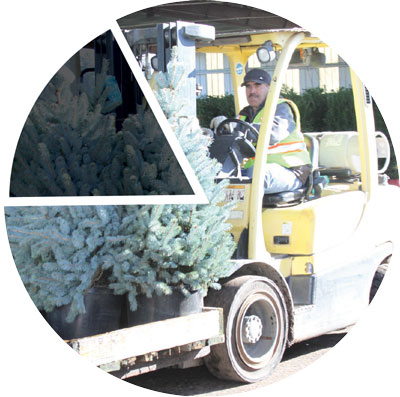 How Trump’s tariffs and trade policies are impacting Oregon’s nursery industry
How Trump’s tariffs and trade policies are impacting Oregon’s nursery industry
Jeff Stone has been in the nursery industry in Oregon for nearly 15 years. And in that time, the executive director of the Oregon Association of Nurseries has seen his share of industry ups and downs, particularly in the area of trade. Most recently, he’s seen it swing wildly under President Donald Trump.
But even though it might seem more extreme under Trump, the tariffs and trade policy tit-for-tats are nothing new.
“It’s not unusual to have disagreements over trade,” Stone said. “Trump is not the first president to engage in all this, and he won’t be the last.”
But this time around, there is something different. This time, the steep tariffs and trade tightening imposed by the Trump administration — which triggered retaliatory tariffs from China, Canada and the European Union — seem to be missing something: A plan.
“My main criticism of all this is that I don’t know if the administration has a real plan,” Stone said. “The political side of this is as much drama and theater as anything else. But if you’re just upsetting markets and there is no real plan — I just don’t like the optics.”
Plan or no plan, the trade and tariff environment has shifted dramatically over the past two years under Trump. This year alone, the Trump administration has levied or proposed billions in new tariffs on everything from steel and aluminum to automobiles, televisions and plastics. While the nursery industry may not be as directly affected as some other fields within agriculture and horticulture, there are impacts and concerns that have the industry on edge and ready to react. There’s also a general sense of uncertainty that’s hanging over the market.
“We know the additional tariffs have had impact on our exports and imports over the past six months,” said Alexis Taylor, director of the Oregon Department of Agriculture. “What we don’t know is how well-established trade relationships will fare during this time of uncertainty.”
What’s at stake
When it comes to international exports, Oregon’s nursery industry may not be hit as hard as some when trade policy changes and tariffs ratchet up. Just over 5 percent of what is produced here in Oregon is exported to other countries, including Canada, China, Europe and elsewhere. The rest stays statewide, with 26 percent remaining in Oregon, 25 percent going to western states, about 20 percent heading to the Midwest, 12 percent going to Atlantic and Gulf states and 13 percent going to the Northeast.
According to Craig Regelbrugge, senior vice president of AmericanHort, part of the reason the nursery industry is shielded a bit from direct impacts to new retaliatory tariffs from other countries is the fact that trade in live plants is somewhat limited by quarantine restrictions that are designed to prevent the movement of serious plant pests and diseases. Live plant exports from the U.S. are similarly limited.
The larger Oregon agriculture industry is a little more vulnerable and, as a result, concerned about new tariffs and trade shifts, according to Taylor.
“The uncertainty around federal trade policy with China is causing concern in the agricultural community and for good reason,” she said. “China is one of Oregon’s top agricultural export markets. In 2017, more than $290 million in Oregon food and agricultural products were shipped to China, the state’s fourth largest market.”
Even so, thanks to a list of more than 1,300 goods from China impacted by the Trump administration’s new tariffs, Oregon’s nurseries do face the potential of higher costs for a variety of inputs required to produce plants. Those include plastics — think products such as pots and stakes — as well as farming equipment and components, fertilizer and other goods.
“During my tour of nurseries in the Willamette Valley in September 2018, I heard concerns from growers that additional tariffs on key inputs are raising the cost of doing business,” Taylor said. “The effects of additional tariffs are widespread and can be found in both products we export and import in agriculture.”
Regelbrugge said AmericanHort recently heard from a fruit tree nursery stock producer in the Pacific Northwest who was stuck with a $50,000 tariff bill for a container load of fiberglass tree stakes.
“So we may see input costs rising until the tariff spat settles down,” he said.
In addition, Regelbrugge said a number of specialty flower and vegetable seeds are produced under contract in China. Volumes of those produced are often too small to be of interest to domestic producers here in the U.S.; nonetheless, some of them were included in the last round of tariffs, “so some seed supply chain impacts are being felt,” he said. Tree fruit and tree nut industries have also had their export markets hit hard. That could lead producers to scale back planting, which in turn could end up hurting the propagation nurseries that produce fruit and nut tree planting stock.
 Taxing times
Taxing times
On top of Oregon nurseries feeling the impact of trade tensions and the new tariffs, ultimately consumers will, too.
Charlie Hall, professor and the Ellison Chair in the Department of Horticultural Sciences at Texas A&M University, said every time tariffs are levied, it’s the consumer who pays the bill. And those higher prices, Hall said, end up canceling out some of the savings that may have come from Trump’s tax cut bill of 2017.
“The tariffs are like a sales tax for our products,” said Stone.
Severely increasing tariffs and edging toward a trade war also puts at risk the valuable relationships that Oregon nurseries and others in the agriculture industry have worked so long and hard to establish. Stone said those kinds of relationships take a lot of time and effort to build. Policy decisions that aren’t well thought-out can put those relationships at risk.
“Oregon businesses have many long-standing relationships in China, some spanning decades,” Taylor said. “At ODA we are working to strengthen those relationships through continued talks and trade missions.”
The trade-offs
There are other efforts, aside from trade missions like those the ODA conducts, to help soften the tariff blow on Oregon nurseries and the industry in general. Regelbrugge said those include teaming up with other industries who might be feeling the same pinch.
“The tariff issues and dynamics are, as a general matter, way bigger than our industry, and so are the pressures to resolve them,” he said. “One area where we share something in common with other sectors, like the high-tech sector, relates to intellectual property. Some of the world’s foremost plant breeders and innovators are here in America, and they would benefit from more robust plant intellectual property protection schemes in countries like China. If the tariff wars lead to better Chinese laws and compliance that will be a positive.”
As evidenced in early December, after Trump met with Chinese President Xi in Argentina, the ongoing trade dispute is likely to continue meandering and morphing as the administration’s trade policies evolve. There have been some hints that certain tariffs might be scaled back on both sides of the table. The December signing of the United States-Mexico-Canada Agreement, also known as the “New NAFTA,” has helped calm some fears.
There may be some long-term good to come out of the current trade upheaval, but Regelbrugge said too many wrong steps could also have dire consequences.
“In my own humble opinion, the tariff and trade tensions have had some legitimate basis. In the case of China, for instance, everyone believes that the country has been a fair partner. If the tensions result in real gains, that’ll be to the good,” he said. “On the other hand, many sectors have seen market access disruption and greater costs and uncertainty. Ultimately, trade tensions or even wars are not good for the business cycle and the economy, and if they drag on, they may contribute to the next inevitable tipping point toward a recession.”



